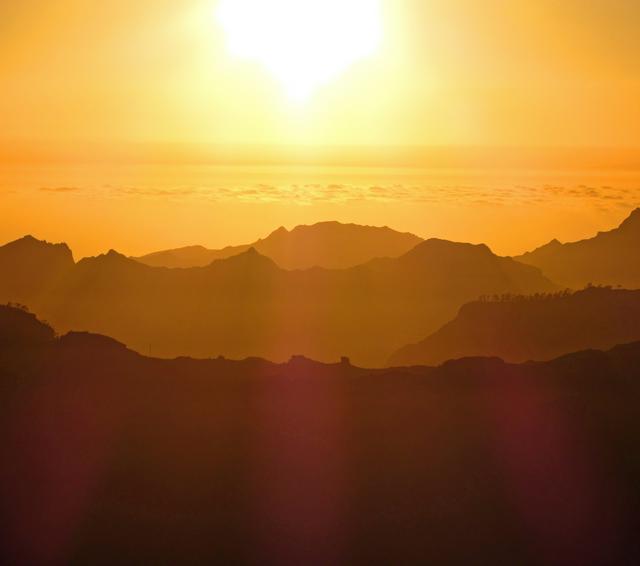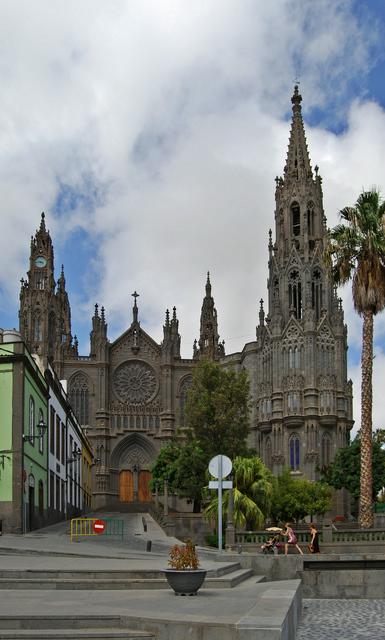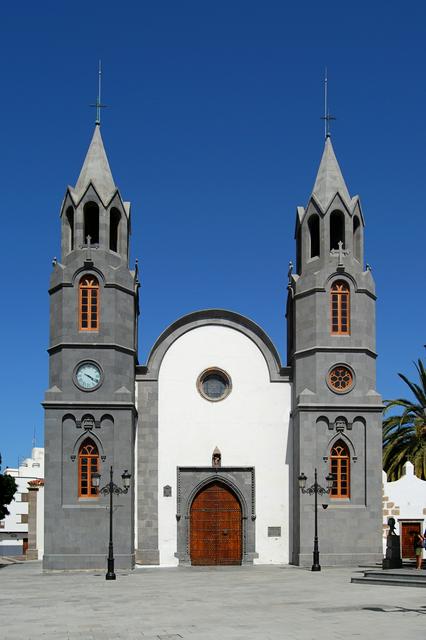 Gran Canaria is the third largest island in the Canary Islands and has the largest population. It's often described as a "continent in miniature" because it has so much variety to offer.
Gran Canaria is the third largest island in the Canary Islands and has the largest population. It's often described as a "continent in miniature" because it has so much variety to offer.
- Risco Caído. — archaeological containing prehistoric cave dwellings, temples, and granaries attributed to the pre-hispanic culture of the Canary Islands.
Risco Caído. — archaeological containing prehistoric cave dwellings, temples, and granaries attributed to the pre-hispanic culture of the Canary Islands.
The capital Las Palmas de Gran Canaria, in the northeast of the island, is one of Spain's largest cities. The south coast of the island is now dominated by the tourist resorts which generate most of the island's economy. The centre of the island is mountainous, with the remains of ancient pine forests on the peaks. Maspalomas in the south of Gran Canaria is the tourist zone, with the largest variety of options for enjoying the island. For tourist information or specific help, the TI Center is in Yumbo Center.
The official language of Gran Canaria is Spanish. However, one hears many people speaking English and German in the tourist areas.
The local inhabitants speak Canario, a Spanish dialect characterized by a slightly more singing tone than the mainland, less clear pronunciation and incorporation of different verb tenses. Even for foreigners with a basic knowledge of Spanish, the varieties spoken on the islands can take some time getting used to. On Tenerife however, the pronunciation seems to be more neutral, and leans a bit more toward normalized Spanish. In a way is very similar to Chilean Spanish. Canarian is known by;
- loss of ending 's' in most plural unstressed words into a "h" or "sh" sound (relojej instead of relojes),
- diphthonging words and verbs (callao for callado, pesao for pesado),
- emphasis of the H sound when normally mute (hediondo pronounced jediondo and not ediondo),
- different verb tense (ayer juguemos un partido instead of ayer jugamos un partido),
- use of Haiga instead of haya (as the verb "to have") and
- use of simple past tense instead of past participle tense, resulting in the occlusion and almost non-existence of the latter.
The climate is subtropical semi-arid for most locations, but it may vary a lot depending of where you are going. For the main touristic resorts the weather is mostly comfortable.
In Maspalomas there is normally 28-33°C in July at daytime, which drops to 21-24° by night. In winter, day temperature is normally 23° and by night 16-17°. Bad weather can occur, especially between mid-October and March. Temperatures can then drop to 11-12° and be quite windy.
Arguineguín has the best climate, with the least wind, and is, due to its protected location, among the driest in winter too.
Las Palmas has a bit of a different climate, and is sometimes clouded and rain might occur, even in May or June, but it is not very common. If you travel in winter take at least a thick jacket or two. If you plan to travel to the mountains bring or buy a scarf and gloves. The freezing point can be reached on Pozo de Las Nieves.
In summertime, always bring a bottle of water during the day. If winds from Sahara occur and temperatures rise above 40 °C, try to stay in the shadows, close to climatized air and always drink plenty of water.
 The sand dunes in Maspalomas (ask for "Las Dunas de Maspalomas").
The sand dunes in Maspalomas (ask for "Las Dunas de Maspalomas").
- Palmitos Park, Barranco de Los Palmitos s/n. 35109 Maspalomas Gran Canaria, +34 928 797 070. Various animals (esp. exotic birds) and exotic plantations. Also dolphins. Has shows with parrots, dolphins and birds of prey (eagles, hawks, etc). A great place to go with children 2 yr and upwards. You could spend 3-4 hours there.
- Teror. Nuestra Señora del Pino
- Valsequillo. This area is very green with imposing rock formations and steep ravines, It has pine forests, palm groves and almond trees (which are in bloom in January and February) and all kinds of vegetation within its 39.15 km². The historic center and surrounding neighbourhoods offer valuable traces of history like the Church of Saint Michael Archangel, the former Cavalry barracks, and Flemish carvings. The varied gastronomic offer includes traditional cheeses, wine, honey and almonds, all of which make up one of the major attractions of Valsequillo.
- Risco Caido and the Sacred Mountains of Gran Canaria Cultural Landscape. This world heritage site extends over the north, west and central parts of the island.
Palmitos Park, Barranco de Los Palmitos s/n. 35109 Maspalomas Gran Canaria, +34 928 797 070. Various animals (esp. exotic birds) and exotic plantations. Also dolphins. Has shows with parrots, dolphins and birds of prey (eagles, hawks, etc). A great place to go with children 2 yr and upwards. You could spend 3-4 hours there.
Teror. Nuestra Señora del Pino
Valsequillo. This area is very green with imposing rock formations and steep ravines, It has pine forests, palm groves and almond trees (which are in bloom in January and February) and all kinds of vegetation within its 39.15 km². The historic center and surrounding neighbourhoods offer valuable traces of history like the Church of Saint Michael Archangel, the former Cavalry barracks, and Flemish carvings. The varied gastronomic offer includes traditional cheeses, wine, honey and almonds, all of which make up one of the major attractions of Valsequillo.
Risco Caido and the Sacred Mountains of Gran Canaria Cultural Landscape. This [[world heritage site]] extends over the north, west and central parts of the island.
- Biking. The island is a paradise for bikers, with lots of trails for mountain biking, from easy to very difficult and long ones. There are also many possibilities of road biking, both in the mountain region and along the coast. There are bike rental centers in the island.
- Surf Canaries Surf School, +34 677704981. Gran Canaria is a perfect place to learn to surf. A surf class will set you off safely with the right technique. Use a reputable surf school such as Surf Canaries, a mobile surf school in the south of the island who take parties to the right beaches for learning and give in depth and fun classes with qualified instructors. It's a great day out if you always fancied having a go!
Gran Canaria is a paradise for hill walking with its inhabited cave villages, lake side walks, spectacular mountain scenery and wonderful flora & fauna especially in the Spring. There are a great variety of hikes on outstanding trails, many of these are off-the-beaten-track and the climate is excellent for trekking.
The south of Gran Canaria is famous for the variety of beaches. The longest beach is "Playa del Inglés" and "Maspalomas", the almost 4 km stretch of beach between Playa del Inglés and Meloneras is a serviced nudist beach. In the Mogán area there are other famous beaches, such as "Amadores", "Anfi del Mar", "Puerto Rico", and "Playa de Mogán."
Described as the "Hawaii of the Atlantic", the surf on Gran Canaria can be incredible. On the right day the surfers will put on a free and spectacular display, often in the north of the island but also in the south on the right conditions - Maspalomas, Playa del Inglés and Arguineguin.
It is also a great place to learn to surf with fantastic beaches and a couple of really good surf schools.
The island is home to Spain's oldest golf club plus eight newer courses, mostly in the south of the island.
The south part of the island has many great diving locations and many dive centers. Most arrange daily trips Monday to Saturday with hotel pickup and reasonable equipment rental prices. Most travel guide books suggest one or two dive centers.
Near Maspalomas, Let's go diving arranges boat tours to natural and artificial reefs with a variety of fish and other species. A wreck dive is also possible within 20 m depth. You may find flashier rental equipment but you will hardly find better personnel.
In Arquineguin, Scuba Sur Diving Center, inside the Time Share Resort Anfi Del Mar, organize daily diving trips, free scuba diving try every day in the different pools, all PADI courses till Instructor Development Course; three times a week snorkeling trip to the Pristine Bays of Gran Canaria from amazing beach of Patalavaca and the small and wonderful private marina, from where boats are leaving.
Biking. The island is a paradise for bikers, with lots of trails for mountain biking, from easy to very difficult and long ones. There are also many possibilities of road biking, both in the mountain region and along the coast. There are bike rental centers in the island.
Surf Canaries Surf School, +34 677704981. Gran Canaria is a perfect place to learn to surf. A surf class will set you off safely with the right technique. Use a reputable surf school such as Surf Canaries, a mobile surf school in the south of the island who take parties to the right beaches for learning and give in depth and fun classes with qualified instructors. It's a great day out if you always fancied having a go!
 Besides many good restaurants of different nationalities, the Canarian Cuisine is especially worth trying.
Besides many good restaurants of different nationalities, the Canarian Cuisine is especially worth trying.
Most restaurants serve local wines as well as Rioja.
La Casa Vieja: (North area of Maspalomas) serve Canarian meals like Gofio, fish, squid rings, octopus with vinegar, Papas arrugadas con mojo (salted potatoes with a spicy mix), and grilled meat.
In Las Palmas there are many excellent fish restaurants, specially along the coast near Las Canteras beach and El Confital in the neighborhood of La Isleta. An exquisite dish is Chancletes al limón, but many other local fresh fish are excellent too.
Restaurant Ciao Ciao near the beach in Las Meloneras serves an Italian cuisine with good pizzas, meat and fish dishes.
Restaurante Olivia in Puerto de Mogán serves well prepared local dishes near the yacht harbour in Puerto de Mogán.
As an aside, when staying in the area of Playa del Inglés, expect to be regularly solicited by "waiters" who want you to eat at the restaurant they are working for. It can't be avoided but becomes slightly less annoying over time.
If you are in Maspalomas then you must visit Samsara. Making a booking at least a week in advance is a wise decision. The portions are enormous so order per couple. Arriving in beach shorts and a t-shirt will make you feel under dressed so dress smart-casual. You should not hold back and spend some extra money for desserts and anything you get offered. It may be the best restaurant on the island, not just because the food is nearly perfect but it has an amazing Asian décor, out of the world vibe and extremely welcoming staff.(2012)
The Yumbo Centrum dominates the centre of Playa del Inglés. It has dozens of restaurants, bars and clubs, many catering to the gay community, particularly on the higher floors.
Some of the cheaper bars are on the Western side of the ground floor.
Busy gay bars are Construction on the ground floor and Terry's Show and XL on the first floor. The top floor has dance bars such as Mykonos and Mantrix that are a mix of bar and clubs, and tend to be more expensive. Heaven also has a club here, on the third floor. A selection of real English teas can be found at Café Florín, also known as the Internet Cafe one minute from the Yumbo, down the hill towards the Playa del Inglés beach.
There is relatively little crime in the resorts, the main annoyance is drunks causing trouble. As anywhere, one should not leave valuables unattended on the beach.
In Las Palmas de Gran Canaria, applying common sense for large cities is advisable. Some of the streets can be badly lit and the area around the harbour can be a bit threatening.
In the south, young guys may attack aged people trying to tear off a bag. It may happen even in the daytime on the central streets of Playa del Inglés.
On the beach, African women vendors may try to put a bracelet on your wrist and then charge an exorbitant fee for it. They will almost always approach you with a badly spoken "whea' you from my friend". Pay no attention and walk away as quickly as possible or you will be plagued. Some of these women can be aggressive however, so always be on your guard. Scream "Molestado!" if you have to and if you are forced into having to pay for bracelets, make sure you have a few small bills or change and convince them it's all you have.
Gay travelers be warned about being approached by very dark skinned Moroccan men. You can tell they are not Spanish from their different hair texture. They can approach you for sex tourism, and will tell you a cheaper price and then ask for more and more, so make sure you agree on one before. Or they can be very aggressive and not leave your place. one way of deterring them is telling them you are being treated for an STD, although you may be heavily insulted for this. It may also be recommended to do anything you want to do, in the many bars or clubs with darkrooms and places.
If you've been to Tenerife, you may be familiar with the so-called Lookey Lookey Men. Since they are not as common in Gran Canaria, they are usually not seen as problem, but can be annoying as they try to sell cheap items which are usually bootlegs.
